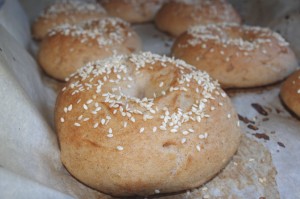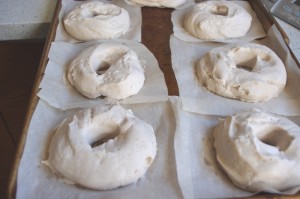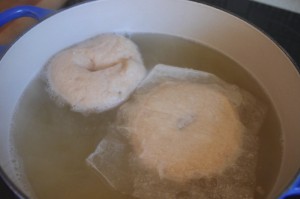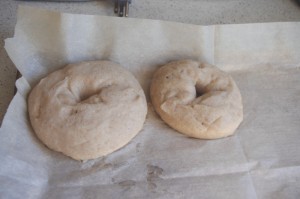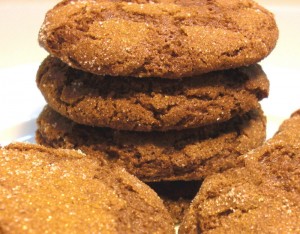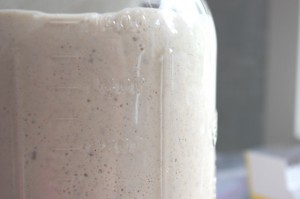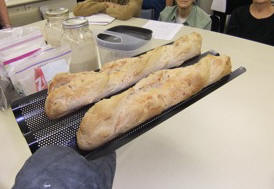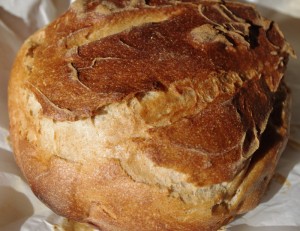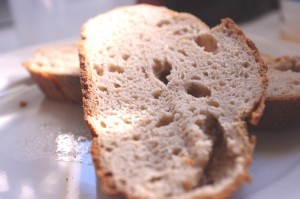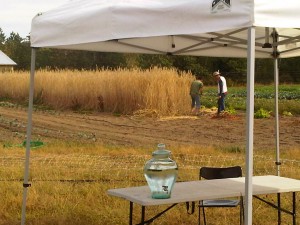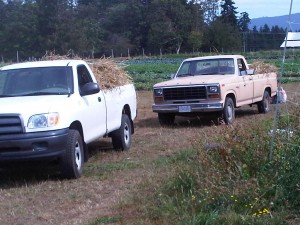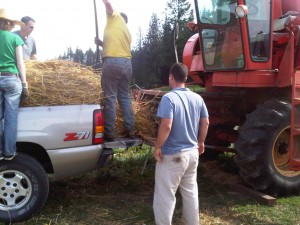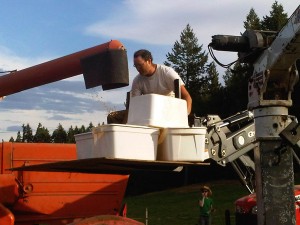As you may recall, I’ve been trying for a while to get really good chewy gluten-free bagel going, and have found that even the recipes that contained eggs resulted in more fluffy bagels, rather than that chew and density that goes along with the Montreal style bagels. As I started playing around with wild yeast starters, I found that I was starting to see some of the texture I was after in the baguettes, especially when slow-risen overnight.
So with a wild-yeast starter in hand (I use a slight variation of Dr. Jean Layton’s sourdough starter and flour blend — I use a smaller amount of white bean flour, AND I also substitute half the sorghum flour for millet flour) — at 100% hydration levels.
When feeding my starter, I use equal parts of the gluten-free flour blend and water, usually about 1/2 cup of each. I whisk it well, and then add to the wild yeast starter I’ve had in the fridge. Before you feed your starter, let it warm up to room temperature (After all, YOU don’t like eating when you’re cold and sleepy, do you?!), and let it sit at room temperature after until you see lots of bubbles developing. About every third time I feed it, I also add about 1 1/2 teaspoons of potato flour to the mix.
Before using the wild yeast starter (or “hooch”), I find it is most effective if fed the day before or first thing in the morning before you use it. With wheat starter, the purpose of feeding (up to 3 days before), is to strengthen the gluten-structure of the starter, as well as to get the wild yeast perked up. With the gluten-free starter, obviously there is no worry about whether the gluten is happy or not, so its just a matter of waking up with the wild yeast and making sure its well fed and active.
A couple of things I’ve found help make gluten-free bagels that actually look like real bagels:
- the dough will be quite a bit thicker than most gluten-free bread doughs, but will still not be as firm as a wheat-based dough. Shaping the bagels is easiest done by piping them onto parchment paper with either a piping bag with a very large tip, OR with a ziploc bag with one corner cut out. Finish up the smoothing and shaping with wet fingers, and if you want the holes bigger, just stick it in the centre and swirl it around.
- Keep these on parchment paper right up to the point you boil them. I find it easiest to cut around the bagels, so each one is on a little square of parchment. That way you have a little “sling” to help get the bagels into the hot water bath. I put them in the water, parchment side down, flip them over, and then ease the parchment square off the bottom.
- These are more delicate than wheat-based bagels, so use a nice wide slotted spatula to fish them out of the hot water batch.
- Barley malt extract in the bagels and the water helps give wheat-based bagels their characteristic taste and sheen. The closest you will find that is gluten-free is Brown Rice syrup.
- Just like wheat-based bagels, bake these at high heat.
Printer friendly (GF wild yeast bagels)
Gluten-free Wild yeast bagels
Makes 7-8 medium sized bagels
-
- 450 grams gluten-free wild yeast or sourdough “hooch”
- 75 grams tapioca starch or potato starch
- 75 grams cornstarch
- 75 grams millet flour
- 38 grams sorghum flour
- 38 grams sweet rice flour
- 1 1/2 teaspoons sugar or honey
- 1/2 teaspoons salt
- 1 1/2 teaspoons guar gum
- 1 Tablespoon xantham gum
- 225 ml water
Combine all the dry ingredients in a medium bowl and mix well. Add the “hooch” and the water to the mixing bowl of a stand mixer. Add the dry ingredients and mix with the paddle attachment at medium speed for 4 minutes until the batter is very smooth.
Put the batter into a piping bag (or alternately, you can use a large Ziploc bag with the corner cut out). Pipe out 7-8 bagels onto parchment paper (each one 3-4” across). Cover with plastic wrap and let rise in a cool place for at least 4 hours (or overnight in the fridge). Cut the parchment in squares around each bagel.
Preheat the oven to 450 degrees.
Prepare a water bath in a large dutch oven — bring the pot of water to the boil, and add 2 Tablespoons brown rice syrup. When the water boils, add 1 Tablespoon baking soda. Drop the bagels in the water (parchment side up — it will detach on its own). Boil briefly, 30 seconds per side, removing the parchment square as you take the bagels out of the water bath and remove to a parchment lined baking sheet. Sprinkle with seeds if desired.
Bake at 450 degrees for 20-25 minutes. Let cool on a baking rack before slicing open.
As with all things yeasty over here, we’re sending this over to YeastSpotting. Go check out all the fabulous things baked with yeast ![]()
I know I promised the gluten-free bagel recipe, but am still double checking my measurements before putting the recipe out there for y’all. In the [...]]]>
I know I promised the gluten-free bagel recipe, but am still double checking my measurements before putting the recipe out there for y’all. In the meantime, here’s a little gluten-free, dairy-free treat to get you feeling all Yuletide-ey. These are simple enough that you can do all the mixing by hand — the Earth Balance softens to a quite workable texture. You can also use butter if you are eating dairy — just make sure its softened at room temperature for a while.
These are rolled in sugar and get a nice crackled top when baked. Try them out — you won’t believe they’re not gluten!
Gluten-free Molasses Spice Cookies
Mix together dry ingredients with a whisk
- 1/2 cup sorghum flour
- 1/2 cup teff flour
- 1/2 cup tapioca starch
- 1/2 cup cornstarch
- 1 tsp. cinnamon
- 1 1/4 tsp. ground ginger
- 1 tsp. allspice
- 1/4 tsp. ground cloves
- 1/4 tsp. ground black pepper
- 1 tsp. xantham gum
- 1 tsp. baking soda
- 1/2 tsp. baking powder
- 1/4 tsp. salt
- 1/2 cup Earth Balance shortening
- 2/3 cup sugar
- 1/4 cup cooking molasses
- 1 egg
Cream together the Earth Balance and sugar. Add in the cooking molasses and the egg and mix thoroughly before adding the dry ingredients.
Drop by tablespoons and roll in sugar before placing on a parchment-lined cookie sheet. Bake at 350 for 12-13 minutes.
]]>As you know, I have had the wild-yeast starter going for a while now and been baking fairly regularly with it. Expect some posts to come on the different things you can do with it besides just bread.
In the meantime, in my quest for [...]]]>
As you know, I have had the wild-yeast starter going for a while now and been baking fairly regularly with it. Expect some posts to come on the different things you can do with it besides just bread.
In the meantime, in my quest for the perfect gluten-free bagel, I’ve been playing around with hydration levels and long rise times in an effort to get a texture closer to the perfect chew of a Montreal style bagel. I think we’re nearly there!
While this is in baguette form, it had a long, slow rise overnight in the fridge, has a hydration level closer to 67 percent, rather than the usual 100 percent i work with as a starting point for gluten-free breads, and its a lot easier to form into ropy lengths, perfect for turning into bagels! Hub also liked the flavour (no mean feat that!) pronouncing it pleasantly sourdough-ey
I leave you with … the soon to be bagel
]]>I was also [...]]]>
I was also invited to attend the most recent Victoria Chapter meeting of the Canadian Celiac Association to do a bread baking demo, where we walked through using the wild yeast starter for sourdough baguettes. When you combine the use of the wild yeast starter, with basic ratios, and opt to weigh your ingredients, the baking is actually much more intuitive than conventional gluten-free bread baking, and is quite a bit more forgiving in terms of temperature variations, rise times etc. Here`s 2 baguettes fresh from the oven, where we were`t quite sure how well calibrated the oven was, and had to cut the rise time short!
As I noted in the last post, Dr. Jean Layton has also been working on her sourdough recipe, and just posted hers today on her recipes blog. It`s always interesting to see what different approaches different gluten-free bakers opt to take — she has achieved a fabulous result with a lower hydration level (somewhere closer to the typical 67% hydration level you would get with a 1-2-3 sourdough formula).
When I was playing around with the sourdough starter, I opted for a higher hydration level, which allows you a shorter rise time (good if you`re in a hurry) because the dough is considerably softer, but I also started with a smaller amount of starter.
So here you go: This recipe makes both baguettes and boules. If you opt to make 1 large boule, you can cut the liquid down by about 1/4 cup. Mound the dough onto a piece of parchment, smooth into a round boule shape and let rise until nearly double in size. While the boule is rising, preheat the oven AND a lidded cast-iron dutch oven to 450 degrees. Slash the dough before baking, plop the dough on the parchment into the hot pan, cover with the lid and bake in the oven at 450 degrees for 25 minutes. Remove the lid, reduce the oven to 400 degrees and cook for another 30-35 minutes, until the internal temperature reaches 205 degrees.
Gluten-free Wild Yeast baguettes (Printer friendly recipe)
1-2 hours before you plan to bake, remove the “mother” starter from the fridge, mix together your “starter” for the recipe …
- 1/2 cup sourdough starter
- 1/2 cup water
- 1 Tablespoon potato flour (NOT starch)
Let sit, covered for 1 –2 hours to get the wild yeast going again.
In a medium bowl, combine dry ingredients and whisk well
- All of the starter you made earlier
- 1 Tablespoon honey
- 1 Tablespoon neutral flavoured oil
- 1 1/2— 1 3/4 cup water
Add the dry ingredients to the mixer, and mix at medium speed for at least 3 minutes until the dough becomes smooth
- 200 grams Jean’s sourdough flour*
- 50 grams cornstarch
- 50 grams tapioca starch
- 2 1/4 teaspoons xantham gum (or guar gum)
The dough will be very soft and billowy, and should be wet enough to allow it to rise easily. If it looks like it needs more water, add 1-2 T at a time.
Use a scoop to place the dough in a greased baguette pan. Smooth out the baguettes and slash. Let sit, covered for at least 1 hour, and up to 4 hours. You can also raise the baguettes overnight in the fridge for further development of the flavours.
20 minutes before baking, preheat oven to 425 degrees.
Bake for 30-35 minutes
* Sourdough flour blend (makes 1 large batch of flour, weight, 145 grams per cup)
- 583 grams brown rice flour
- 583 grams sorghum flour
- 583 grams millet flour
- 290 sweet rice flour
- 74 grams garfava flour
- 155 grams white bean flour (I switched the proportions of the garfava/white bean flours)
To make a starter: Mix at 100% hydration (equal parts water and flour), let sit 2 days at room temp until it starts to bubble.
After 2 days, you can start to feed the starter — approximately 1/4 the volume of the total starter. (e.g. if the starter is 2 cups, feed it with 1/4 cup flour + 1/4 cup water. Every 3rd feed or so, adding 1T potato flour will help promote active yeast growth in the starter.
If you keep the starter in the fridge, feed it approximately 1 x per week, or every time you take it out to bake. The starter can be used for breads, but can also be used to leaven other things from muffins to pancakes — just bear in mind that your final product will have the “tang” of the wild yeast starter.
As always, if it has yeast in it, we send it over to Yeastspotting, that bloggy repository of all things yeasty and baked! If you haven`t checked it out, its very inspiring to check out the amazing baking!
]]>We always associate grain-growing with prairie farming, but, in fact, grain has been grown successfully on Vancouver Island in days gone by, and one of the interesting things about landrace varieties such as Red Fife, is that they are quite adaptable, and develop flavours and characteristics unique to the region growing them. We also don`t see a lot of organically grown whole grains such as rye, and I was also curious to see how a hardier grain would fare in our climate.
My share of the harvest was roughly to 875 square feet of growing space, some of which was devoted to Red Fife Wheat, some to Hard White Spring Wheat, and some to Rye. Heather and Brock also organized the Threshing through another Cowichan Valley farmer with a small combine, and have plans for one more workshop on cooking with whole grains.
Harvest day actually ended up being delayed by a week — with all the funny weather we’ve been having through the summer, the grain needed another week to fully dry. Sunday, I woke up to sunny weather, and headed up island, with a thermos of coffee, lots of water, and a packed lunch!
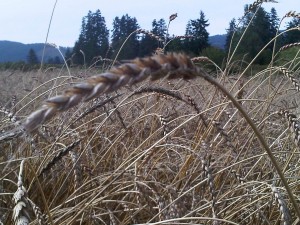 Brock and Heather had planted three grains this year — some of which had been planted last fall, and some of which were planted in the spring. It was interesting to see the differences between the same varieties planted at different times of the year. Many of the grains are quite happy being fall-planted, and there was a marked difference in the rye which Brock had not only planted in the fall, but interspersed with fava beans!
Brock and Heather had planted three grains this year — some of which had been planted last fall, and some of which were planted in the spring. It was interesting to see the differences between the same varieties planted at different times of the year. Many of the grains are quite happy being fall-planted, and there was a marked difference in the rye which Brock had not only planted in the fall, but interspersed with fava beans!
The Red Fife wheat is a heritage variety, which, while good for baking (excellent flavour and protein content), runs the risk of lodging (falling over). The stalks are decidedly more slender. For the drawbacks though, for those planting and harvesting on a smaller scale, this was much easier to load into the trucks, compacted more easily, and did not have much in the way of prickly awns.
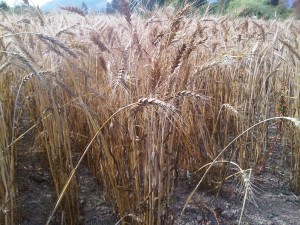 The Hard White Spring wheat, on the other hand, is much more compact, with sturdy stems and lots of protection from marauding fauna due to the awns. While it cut very easily, it took a great deal more effort to pack the trucks for their trip to the combine, and I`m still picking prickly bits of awns out of my underwear!!!!
The Hard White Spring wheat, on the other hand, is much more compact, with sturdy stems and lots of protection from marauding fauna due to the awns. While it cut very easily, it took a great deal more effort to pack the trucks for their trip to the combine, and I`m still picking prickly bits of awns out of my underwear!!!!
Finally, the Rye turned out to be very prolific. Some of the seedheads were a full 4-5 inches long!!! The stems of the rye that Brock planted with the fava beans were easily 6 feet tall, and actually got harvested by the Cowichan Valley Ecovillage to use as thatching for some of their demonstration buildings. These guys were harvesting fairly carefully, creating nice neat bundles as they went. Despite being so tall the stems were remarkably sturdy, showing little sign of toppling over. The rye (similar to barley), also has a built-in indicator of ripeness, where the seed-head nods so its parallel with the stem, curling right back on itself as it dries.
During the course of the day, we harvested all of the grain by hand — a combination of scythe, sickle and shears — creating piles as we went. The harvest went fairly quickly, and was loaded into the waiting trucks in batches (to keep each grain separate) to be taken off to the combine. It is possible to thresh by hand, but the combine was MUCH faster!
At the combine, the grain got fed into the combine with a fork — through the rotating drum, with the straw coming out the back end. A couple of people at the back end were needed to feed the straw into the baling machine, which resulted in a good number of bales of organic straw for Heather and Brock to use in the fields.
Finally, the grain, once threshed, was collected in plastic bins — you can see Brock, hoisted up near the chute, making sure the rye actually got into the bins!
All told, we had 12-15 folks helping throughout the day — most of whom, like me, were inexperienced at this kind of thing. Total harvest, about 900 lbs of grain, with a bit left on the ground to fatten up the chickens!
For my share, I now have 10 lbs Red Fife, 10 lbs Hard White Spring wheat and 20 lbs Rye. I`ll be making bread with some, using some as whole grain (wheat or rye berries), and perhaps saving a little for seed for next year. I`m already looking forward to next year!
]]>